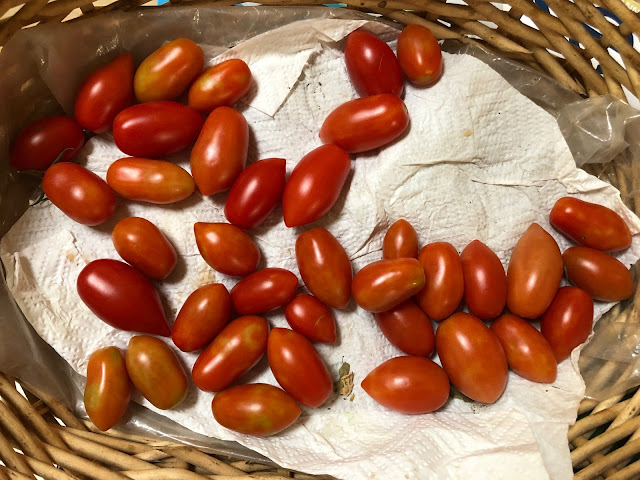
Some reader reports and some advice on those green ones

|
| These Juliets were more green that red just Wednesday. A day later, several are ripe enough to be used in a salad. (Photo: Kathy Morrison) |
The tomatoes aren't completely gone, so we're going to talk about them one more time this fall. First, a couple of readers shared their experiences.
Pam McCabe:
"Speaking of tomatoes. I planted a Mortgage Lifter for the first time this year - not one tomato. I was so disappointed. I had big hopes for that one! My Bumble Bee cherry tomato is still going. Taking awhile for the green ones to turn red."
Kathy's comment: Mortgage Lifter is a wonderful tomato, but it's a big ol' heirloom. I'm beginning to believe that the Sacramento area is getting too hot to grow heirlooms. Even in good conditions, they take forever to produce, and then don't have much of a yield.
"Farmer Fred" Hoffman had a discussion with Don Shor (of Davis' Redwood Barn Nursery) on his Garden Basics podcast in May about NOT growing heirlooms in our regions. (If you want to hear it, that part starts at minute 14:31.) Shor recommends well-adapted hybrids. Yet these old-time varieties -- Brandywine being another classic -- are often why gardeners dive into tomato-growing. Any readers have success with heirlooms this year?
Cherry tomatoes are usually the type that do well no matter what's going on with the weather. (The exception this year: the infamous Sun Gold meltdown that affected so many gardens and which Debbie wrote about in August .) For anyone looking for a good cherry variety, Pam's success with her Bumble Bee is worth noting.
At least until the weather drops into the low 40s overnight, the green ones will turn red on the plant. They ripen faster inside on the counter. My Juliet tomato, a cherry tomato that resembles a Roma, is the last one standing in my garden, and it's the size of two plants. It produced a huge amount of flowers in mid-September, and now it has green and "blushed" tomatoes all over it. I picked several Wednesday and, as you can see in the photo above, many are close to fully ripe already.
If you have to pull a plant that still has a lot of green tomatoes, pick them off and enclose them in a brown paper bag, and include an apple or banana. The gas given off by the fruit will help ripen the tomatoes. They won't be as luscious as those picked in the summer, but they'll still be better than anything store-bought.
I've read of, but never tried, pulling an entire plant and hanging it, upside down, in the garage to ripen the green tomatoes.
For another reader's experience, here's Donna Murrill:
"I live in Durham, CA about 90 miles north of you. We had more days of over 90 weather and more over 100. About the same results however. I did not use shade cloth on the tomatoes. But in the three spots I grew them they get some shade from large trees at different parts of the day.
Comments
0 comments have been posted.Sacramento Digs Gardening to your inbox.
Food in My Back Yard Series
May 6: Maintain soil moisture with mulch for garden success
April 29: What's (already) wrong with my tomato plants?
April 22: Should you stock up on fertilizer? (Yes!)
April 15: Grow culinary herbs in containers
April 8: When to plant summer vegetables
April 1: Don't be fooled by these garden myths
March 25: Fertilizer tips: How to 'feed' your vegetables for healthy growth
March 18: Time to give vegetable seedlings some more space
March 11: Ways to win the fight against weeds
March 4: Potatoes from the garden
Feb. 25: Plant a fruit tree now -- for later
Feb. 18: How to squeeze more food into less space
Feb. 11: When to plant? Consider staggering your transplants
Feb. 4: Starting in seed starting
Sites We Like
Garden Checklist for week of May 4
Enjoy this spring weather – and get gardening!
* Plant, plant, plant! It’s prime planting season in the Sacramento area. Time to set out those tomato transplants along with peppers and eggplants. Pinch off any flowers on new transplants to make them concentrate on establishing roots instead of setting premature fruit.
* Direct-seed melons, cucumbers, summer squash, corn, radishes, pumpkins and annual herbs such as basil.
* Harvest cabbage, lettuce, peas and green onions.
* In the flower garden, direct-seed sunflowers, cosmos, salvia, zinnias, marigolds, celosia and asters. (You also can transplant seedlings for many of the same flowers.)
* Plant dahlia tubers. Other perennials to set out include verbena, coreopsis, coneflower and astilbe.
* Transplant petunias, marigolds and perennial flowers such as astilbe, columbine, coneflowers, coreopsis, dahlias, rudbeckia and verbena.
* Keep an eye out for slugs, snails, earwigs and aphids that want to dine on tender new growth.
* Feed summer bloomers with a balanced fertilizer.
* For continued bloom, cut off spent flowers on roses as well as other flowering plants.
* Add mulch to the garden to maintain moisture. Mulch also cuts down on weeds. But don’t let it mound around the stems or trunks of trees or shrubs. Leave about a 6-inch to 1-foot circle to avoid crown rot or other problems.